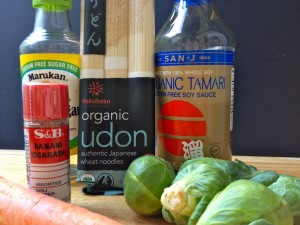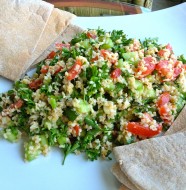 One of my guidelines in choosing which recipes to post is whether the ingredients are readily available at most grocery stores. I’m making an exception this time for two reasons: the first is simply because this recipe is really, really good. The second reason is that my search for the Japanese Seven Spice took me to an Asian market (Jing Jing in Factoria for those of you who live in the Seattle area) where I found a world of amazing products priced much lower than in the Asian food aisle of my supermarket. I came out of there with noodles of all shapes and sizes, sauces, curries and of course the Seven Spice, which is the key ingredient that sets this dish apart from all the other noodle recipes.
One of my guidelines in choosing which recipes to post is whether the ingredients are readily available at most grocery stores. I’m making an exception this time for two reasons: the first is simply because this recipe is really, really good. The second reason is that my search for the Japanese Seven Spice took me to an Asian market (Jing Jing in Factoria for those of you who live in the Seattle area) where I found a world of amazing products priced much lower than in the Asian food aisle of my supermarket. I came out of there with noodles of all shapes and sizes, sauces, curries and of course the Seven Spice, which is the key ingredient that sets this dish apart from all the other noodle recipes.
Seven Spice, or Nanami Togarashi, contains orange peel, black sesame, white sesame, ginger, Japanese pepper, and seaweed. Togarashi is the Japanese word for chilies, and this spice is hot. Shichimi Togarashi is also called seven spice and is a close cousin, with a slightly different proportion of ingredients emphasizing citrus zest. Either one is fine to use in this recipe, but don’t try to substitute Chinese Five Spice- it’s a completely different animal.
The other thing that is an absolute requirement for this recipe is a non-stick skillet. After boiling the noodles you put them in the skillet with a little oil and then cook them and flip them like a pancake. If you don’t use a non-stick skillet, guess what? They stick. I know this from first-hand experience. This method of double cooking the noodles turns out a dish where some of the noodles are crispy, and some are soft. Our friend, James, who gave me the recipe enthusiastically described it, “It’s a feast for the senses. Not only does it taste fantastic, it looks beautiful and smells amazing, and you get the sensory feel of the soft and crispy noodles in your mouth. It’s got it all.”
Note: I added tofu for protein, but it’s optional.
- 1 16-oz package extra firm tofu, drained and pressed dry
- 1 package dried udon noodles, either 9.5 or 8 ounces
- 3 tablespoons canola oil, for cooking
- 6 Brussels sprouts, shredded
- 2 large carrots, shredded
- 1 tsp Japanese Seven Spice, divided
- 3 tablespoons soy sauce, or Tamari
- 2 tablespoons rice vinegar
- If you are using tofu, open the package and drain it. Slice the tofu in half width-wise and put the two blocks on a layer of paper towel. Put several more paper towels on top and a cutting board on top of that. Let sit for about 30 minutes, changing the paper towels when they are soaked. Preheat the oven to 375 degrees and slice the tofu into cubes. Put them in an oiled roasting pan and lightly coat the tofu with oil (I use sesame oil). Bake for about 15 minutes, then turn the tofu over and bake for another 15 minutes. During the last several minutes of baking I add a few dashes of soy sauce.
- Cook udon noodles in boiling water according to the package directions. Rinse with cool water and drain well, getting as much water off as possible.
- Heat 1 tablespoon of the oil in a non-stick saute pan and cook the shredded Brussels sprouts and carrots with ¼ tsp Seven Spice until tender, about 3 minutes. Remove from pan.
- In the same non-stock pan, heat another 2 tablespoons of oil. Add the noodles and press them down evenly across the pan with a spatula, then let them cook undisturbed over medium-high heat for 5-7 minutes. The noodles should turn golden brown on the bottom and begin to form a noodle pancake. When they are cooked enough that you can flip the whole “pancake” with a spatula (or two), turn them over and let them cook several minutes on this side. Add the cooked vegetables on top, along with the soy sauce, rice vinegar and remaining ¾ tsp Seven Spice. Break up the noodles and stir everything together. Once heated through, with some of the noodles crispy and some of them soft, serve with tofu on top.








 Follow the belly on FaceBook, Twitter, or RSS.
Follow the belly on FaceBook, Twitter, or RSS. 

